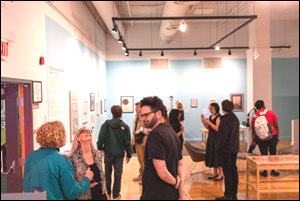Erin McCarthy’s “History of Chicago” class turned the college’s archives into a visual celebration of its legacy with a new exhibit at the Hokin Gallery.
When junior music business major Caeli DiFranco came across a letter from Gwendolyn Brooks in Columbia’s archives, she felt like she’d discovered a conversation across time. The poet’s words, written in looping script, became part of a larger story DiFranco helped tell — one that now fills the walls of the Hokin Gallery in celebration of Columbia’s 135 years of creativity.
This project opened DiFranco’s eyes to the amount of history that the school has stored in the archives.
“You don’t need to be searching the internet for everything. You can just go to our school resources and look for physical artifacts to use in your studies,” she said.
The exhibit, “135 Years in Art and Objects,” runs through Nov. 18 in the Hokin Gallery on the first floor of 623 S. Wabash Ave. and was developed from Columbia’s archives by students in Associate Professor Erin McCarthy’s “History of Chicago” course in Spring 2025.
Photographs, catalogs, posters, videos and other objects dating back to 1890 highlight the college’s history, culture and creative legacy.
Drawing from Columbia’s archives, McCarthy’s students selected, researched and wrote about artifacts they felt best represented the college’s story. This fall, Senior Exhibition Coordinator Mark Porter curated their work, transforming the gallery into a visual timeline of Columbia’s past and present.
McCarthy chose this exhibition project for her students because the archives provide the missing gaps in history that are often overlooked in traditional written history.
“This is the story of their college, and this is everything that made it the college that it is today,” she said.
Students worked in the archives with Heidi Marshall, head of archives and special collections, and Dominic Rossetti, the digital archives and preservation specialist, to handle the artifacts.
Marshall has been working in Columbia’s archives since 2005. Prior to that, the college had no system for keeping artifacts. Throughout Marshall’s career at the college, she has sorted through the archives and worked to collect as many as possible from outside sources. Rosetti has worked alongside her to digitize and preserve these collections.
Rossetti said that through the archives, it shows how Columbia has evolved and accommodated student needs.
“Columbia has always embraced the new technology and really listened to what students want to learn, and that is something you don’t see at every school,” Marshall added.
Madison Yager, a senior art history and art management major, worked as a curatorial assistant and archival assistant on the exhibit project, installing and displaying the pieces, assembling the framing and pulling together the archival section of student spaces for the exhibit.
“Having exhibitions like this gives a reminder to the student body and our legacy. Especially in recent times when the college is in a big flux state, it really stabilizes everything to see what we’ve come from and the amount of things Columbia has done,” Yager said.
While spending time in the archives, Yager saw firsthand how students use the artifacts as resources for creative processes. She said that just by looking through the files, it inspires her to research and to be creative.
“There’s so many collections and different projects that faculty have done with students, and just to witness it all is so empowering,” Yager said.
The exhibit doesn’t just display artifacts. It traces how ideas have evolved, looped back and re-emerged over time.
“You have to understand your roots in order to understand your path,” Marshall said.
The Columbia Chronicle
Copy edited by Vanessa Orozco

